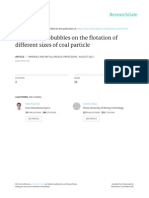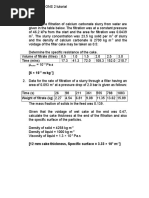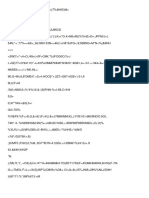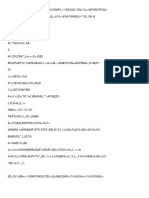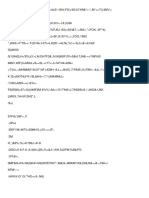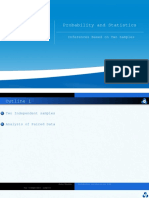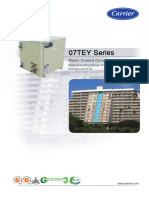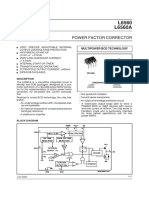DR RS Tutorial Sheet-Mechanical Operations
DR RS Tutorial Sheet-Mechanical Operations
Uploaded by
Nguyễn Hoàng QuânCopyright:
Available Formats
DR RS Tutorial Sheet-Mechanical Operations
DR RS Tutorial Sheet-Mechanical Operations
Uploaded by
Nguyễn Hoàng QuânOriginal Description:
Original Title
Copyright
Available Formats
Share this document
Did you find this document useful?
Is this content inappropriate?
Copyright:
Available Formats
DR RS Tutorial Sheet-Mechanical Operations
DR RS Tutorial Sheet-Mechanical Operations
Uploaded by
Nguyễn Hoàng QuânCopyright:
Available Formats
B.M.S.
COLLEGE OF ENGINEERING, BENGALURU-19
Autonomous Institute, Affiliated to VTU
Department of Chemical Engineering
Tutorial Sheets
Course: Mechanical Operation Course Code: 19CH3DCMOP
Faculty: Dr. Shivakumar. R
Unit 1: Particle Technology
Problem Statements
1. A quartz mixture having the screen analysis shown in Table 1 is screened through a standard
10-mesh screen. The cumulative screen analysis of overflow and underflow are given in Table 1.
Calculate the mass ratios of the overflow and underflow to feed and the overall effectiveness of
the screen.
Table 1: Screen analyses Data
2. A Sand Mixture was screened through a standard 12 mesh screen. The mass fraction of the
oversize material in feed, overflow, and underflow were found to be 0.4, 0.8, and 0.2 respectively.
Calculate the screen effectiveness based on the oversize materials.
3. A Sponge-iron industry uses a screen of 5mm aperture to separate the oversize from undersize
fines which is then recycled to the furnace. The screen analysis of the furnace output was found to
contain 25% fines. The screen effectiveness was 50%. The underflow from the screen contains
around 95% fines. If the furnace production rate is 100 tons/h. Find the product rate and number
of fines present in the products.
Dr. Shivakumar. R Assistant Professor Department of Chemical Engineering
B.M.S. COLLEGE OF ENGINEERING, BENGALURU-19
Autonomous Institute, Affiliated to VTU
Department of Chemical Engineering
4. Table salt is being fed to a vibrating screen at the rate of 150 kg/h. The desired product is -30 +
20 mesh fraction. Estimate the effectiveness of the screen. The mass fraction screen analysis for
oversize 30 mesh and oversize & undersize of 20 mesh is as under. It is observed that oversize is
mesh 30, oversize from mesh 20 and undersize from mesh 20 are in the ratio 2:1.5:1.
5. The screen analysis in the following table applies to a sample of crushed quartz. The density of
the particles is 2650 kg/m3 and shape factors are a = 2 and Φs = 0.571. For the material between 4
mesh and 200 mesh in particle size calculate, (a) The number of particles per gram (b) volume
mean diameter.
Dr. Shivakumar. R Assistant Professor Department of Chemical Engineering
B.M.S. COLLEGE OF ENGINEERING, BENGALURU-19
Autonomous Institute, Affiliated to VTU
Department of Chemical Engineering
6.
7. The screen analysis shown in the following table applies to a sample of crushed galena (Density
= 7650kg/m3), of sphericity (Φs) 0.62. For the material between 4-mesh and 65-mesh in particle
size, calculate Aw, in square millimeters per gram by differential and cumulative analysis method.
Dr. Shivakumar. R Assistant Professor Department of Chemical Engineering
B.M.S. COLLEGE OF ENGINEERING, BENGALURU-19
Autonomous Institute, Affiliated to VTU
Department of Chemical Engineering
Unit 2: Size Reduction
Problem Statements
1. A certain crusher accepts a feed material having a volume-surface mean diameter of 19 mm and
gives a product of volume-surface mean diameter of 5 mm. The power required to crush 15 tonnes
per hour is 7.5 kW. What will be the power consumption if the capacity is reduced to 12 tonnes
per hour?
2. What will be the power required to crush 150 tonnes per hour of limestone if 80 percent of the
feed passes 50 mm screen and 80 percent of the product a 3.125 mm screen?
3. What is the power required to crush 100 ton/h of limestone if 80 percent of the feed passes a
2-in. screen and 80 percent of the product ai-in. screen?
Dr. Shivakumar. R Assistant Professor Department of Chemical Engineering
B.M.S. COLLEGE OF ENGINEERING, BENGALURU-19
Autonomous Institute, Affiliated to VTU
Department of Chemical Engineering
Unit 3: Flow of Fluid past Immersed Bodies
Problem Statements
1. Air flows through a packed bed column. The column is packed with a powdery material of 1cm
depth. The superficial velocity of air is 1cm/s. The pressure drop of 1cm of water across the bed
was measured using a manometer. Porosity of the bed was around 0.4. Assuming Kozeny Carman
equation is valid for the study. Estimate the particle size of powder in terms of equivalent diameter.
2. A packed bed reactor is 2m in diameter. The reactor is packed with cylindrical catalyst pellets
of diameter equal to 1mm and length of 3mm. The height of packing in the reactor is 5m. The
density of the catalyst materials is 2250 kg/m3. The reactor processes a gas stream with viscosity
𝑘𝑔
2.5 × 10−5 𝑚𝑠 and density 2 kg/m3. The mass flow rate of gas through the reactor is around 6 kg/s.
The gas flows downwards into the packed bed reactor and bed voidage is 0.45. Calculate the
pressure drop over the bed.
3. Calculate the pressure drop in terms of cm of water in a packed bed column. The column is
packed with particles of diameter 0.05 cm, density 2000 kg/m3. The height of the bed is 60 cm,
and the bed porosity is 0.5.
Dr. Shivakumar. R Assistant Professor Department of Chemical Engineering
B.M.S. COLLEGE OF ENGINEERING, BENGALURU-19
Autonomous Institute, Affiliated to VTU
Department of Chemical Engineering
4. Water tickles by gravity over a bed of solid particles. The diameter of the particles are 6 cm and
height of solid bed is 2 m. The water is fed into the bed from a reservoir whose diameter is larger
than the solid bed. The water is tickled at a height of 0.1 m above the top of the bed. The porosity
of the bed is 0.3%. Calculate the volumetric flow rate of water required. The viscosity of the water
is 1 cP.
5. Laboratory filtrations conducted at constant pressure drop on a slurry of CaCO3 in H2O gave
the data shown below. The filter area was 440 m2, the mass of solid per unit volume of filtrate was
23.5 kg/m3, and the temperature was 25°C. Evaluate the quantities 𝛼 and Rm. Pressure drop is 112
kPa and viscosity of the water is 0.886 cP.
Filtrate volume, m3 0.5 1.0 1.5 2.0 2.5 3.0 3.5 4.0
Time, sec 6.8 19.0 34.6 53.4 76.0 102.0 131.2 163.0
6. Constant-pressure filtration of a slurry of CaCO3 in H2O. The filter was a 6-inch and the filter
press with an area of 1.0 ft2. The mass fraction of solids in the feed to the press was 0.139. Calculate
the values of 𝛼, Rm and cake thickness. Pressure drop is 35 kPa and viscosity of the water is 0.886
cP. Mass ratio of wet cake to dry cake is 1.59. density of solids 1018 kg/m3.
Filtrate volume, L 0 0.91 1.81 2.72 3.63 4.535 5.44 6.35
Time, sec 0 24 71 146 244 372 524 690
7. For a sludge filtered in a washing plate and frame the filtration equation V2= Kt holds good,
where V is the volume of the filtrate obtained in time t. When the pressure is constant, 30 m3 of
filtrate is obtained in 10 h.
i. Calculate the washing time if 3 m3 of wash water is forced to the cake at the end of
filtration.
ii. If the filtering area/surface is doubled keeping all other things constant, how long would
it take to obtain 30 m3 of filtrate?
Dr. Shivakumar. R Assistant Professor Department of Chemical Engineering
B.M.S. COLLEGE OF ENGINEERING, BENGALURU-19
Autonomous Institute, Affiliated to VTU
Department of Chemical Engineering
Unit 4: Motion of Particles Through Fluids
Problem Statements
Dr. Shivakumar. R Assistant Professor Department of Chemical Engineering
B.M.S. COLLEGE OF ENGINEERING, BENGALURU-19
Autonomous Institute, Affiliated to VTU
Department of Chemical Engineering
Reference
1. McCabe, Warren, L., Smith, Julian, C. and Harriott, Peter, Unit operations of chemical
engineering, 5th edition, McGraw-Hill, Singapore, 2000.
2. Anup Kumar Swain, Hemalata Patra, and Gopendra Kishore Roy, Mechanical Operations, 1st
edition, Tata McGraw Hill Education Private Limited, NEW DELHI.
Dr. Shivakumar. R Assistant Professor Department of Chemical Engineering
You might also like
- Ntsako Jason Maluleke 201209457 P2 Project Stickies TrialDocument27 pagesNtsako Jason Maluleke 201209457 P2 Project Stickies TrialJasontsako_419568363No ratings yet
- Dewatering of Iron Ore Slurry by A Ceramic Vacuum Disc FilterDocument6 pagesDewatering of Iron Ore Slurry by A Ceramic Vacuum Disc FilterReynan Giacomin Borlini100% (1)
- HJW-60 T5: Generating RatesDocument8 pagesHJW-60 T5: Generating RatesKhalid AzmyNo ratings yet
- ENCH2ET Module ExamDocument9 pagesENCH2ET Module Exambrightbunny99No ratings yet
- Classification Final ReportDocument17 pagesClassification Final ReportTivani RindelaniNo ratings yet
- CH122304 Assignment 3Document1 pageCH122304 Assignment 3music junkieNo ratings yet
- Technical Study and Field TestsDocument118 pagesTechnical Study and Field TestsaluxbalumNo ratings yet
- Filtration (Final Report)Document13 pagesFiltration (Final Report)Noel Jeffrey PintonNo ratings yet
- Starch Wastewater Treatment in A Three Phase Fluidized Bed Bioreactor With Low Density Biomass Support Rajasimman, M Karthikeyan, CDocument6 pagesStarch Wastewater Treatment in A Three Phase Fluidized Bed Bioreactor With Low Density Biomass Support Rajasimman, M Karthikeyan, CSomaia Al-AkrsaNo ratings yet
- Review Article Preparation and Applications of The Cellulose NanocrystalDocument11 pagesReview Article Preparation and Applications of The Cellulose NanocrystalAathira AjeeshNo ratings yet
- Institute of Engineering Khwopa College of Engineering Libali-2, BhaktapurDocument6 pagesInstitute of Engineering Khwopa College of Engineering Libali-2, BhaktapurManjesh MishraNo ratings yet
- T Exeter Hydrocyclonemodel2 PDFDocument7 pagesT Exeter Hydrocyclonemodel2 PDFqweNo ratings yet
- Marshall Stability TestDocument5 pagesMarshall Stability TestJoraq YanisNo ratings yet
- Xevvumle 4289Document1 pageXevvumle 4289Dwaipayan PradhanNo ratings yet
- Mechanical Properties of High Volume Fly Ash Concrete: F.N.Okoye, N.B.SinghDocument8 pagesMechanical Properties of High Volume Fly Ash Concrete: F.N.Okoye, N.B.SinghIOSRjournalNo ratings yet
- Mackintosh Probe TestDocument22 pagesMackintosh Probe Testmoin100% (1)
- Assessment of Cement-Sand Mortar Under Direct Compressive LoadDocument7 pagesAssessment of Cement-Sand Mortar Under Direct Compressive Loadyoupick10No ratings yet
- Preparation of A Superior Damping Coating and Study On Vibration Damping PropertiesDocument8 pagesPreparation of A Superior Damping Coating and Study On Vibration Damping Propertiesmicklemagdy50No ratings yet
- Manufacturing Lab REPORTDocument7 pagesManufacturing Lab REPORTSamar AlgheetanyNo ratings yet
- The Role of Degree of Substitution of Cationic Starch On OptimiziDocument49 pagesThe Role of Degree of Substitution of Cationic Starch On OptimiziashishNo ratings yet
- Term PaperDocument9 pagesTerm PaperMohammad KhNo ratings yet
- Quantifiable Crack Detection in Newly Installed Pelton TurbineDocument4 pagesQuantifiable Crack Detection in Newly Installed Pelton TurbineSasankNo ratings yet
- Final Exam Minpro KKI 2022Document3 pagesFinal Exam Minpro KKI 2022emir akbarNo ratings yet
- CG5082 Advanced Transport Processes - W.kwapinski Spring 2013Document11 pagesCG5082 Advanced Transport Processes - W.kwapinski Spring 2013WilliamLoobyNo ratings yet
- MultiphaseflowDocument15 pagesMultiphaseflowAndres VallebellaNo ratings yet
- Effect of Particle Drag On Performance of A Conical Base ClassifierDocument5 pagesEffect of Particle Drag On Performance of A Conical Base ClassifierAdityaRamkumarNo ratings yet
- Experimental Investigation On Impact of MWCNTS For Delamination of GFRP CompositesDocument8 pagesExperimental Investigation On Impact of MWCNTS For Delamination of GFRP CompositesRamesh BabuNo ratings yet
- CHPR4405 Sample Exam2Document7 pagesCHPR4405 Sample Exam2Elena TodorovskaNo ratings yet
- CH3080 Problem Set1to3 2014Document7 pagesCH3080 Problem Set1to3 2014iifNo ratings yet
- Act Lab ManualDocument46 pagesAct Lab ManualAJAYNo ratings yet
- Lectures of Fluid MechanicsDocument84 pagesLectures of Fluid MechanicsMarc Alamo100% (1)
- Mazhar Ahmed (Mass Transfer Report 2020)Document21 pagesMazhar Ahmed (Mass Transfer Report 2020)Abdur RehmanNo ratings yet
- Influence of Successive Washing On Porous Structure of PseudoboehmiteDocument8 pagesInfluence of Successive Washing On Porous Structure of PseudoboehmiteTitis Adisti HapsariNo ratings yet
- Kumasi Technical University Department of Chemical Engineering Mid-Semester - Examination-2020 Cme 228 Particulate Systems HND IiDocument3 pagesKumasi Technical University Department of Chemical Engineering Mid-Semester - Examination-2020 Cme 228 Particulate Systems HND IiMaame Efua NeizerNo ratings yet
- Leclaire Rev1Document6 pagesLeclaire Rev1mackerelfishNo ratings yet
- Effect of Nanobubbles On The Flotation of Different Sizes of Coal ParticlesDocument6 pagesEffect of Nanobubbles On The Flotation of Different Sizes of Coal ParticlesronypassNo ratings yet
- CE 57 Water Supply & Sewerage Midterm ExamDocument2 pagesCE 57 Water Supply & Sewerage Midterm ExamFlorencio B. MaghinayNo ratings yet
- A State-Of-The-Art Review of Mixing in Microfluidic MixersDocument14 pagesA State-Of-The-Art Review of Mixing in Microfluidic MixersMatteo RizzottoNo ratings yet
- 12P305Document2 pages12P305RAJANo ratings yet
- Pulp and Paper 2007 - Paper CGE Systems SDN BHDDocument10 pagesPulp and Paper 2007 - Paper CGE Systems SDN BHDHarald EbbersNo ratings yet
- 45silabus Kimia Sma Versi 120216Document18 pages45silabus Kimia Sma Versi 120216Abdul Gaffar NatsirNo ratings yet
- Fluid Mechanics - Unit 6 - Week 5 - APPLICATIONS OF FLUID STATICS AND DYNAMICSDocument4 pagesFluid Mechanics - Unit 6 - Week 5 - APPLICATIONS OF FLUID STATICS AND DYNAMICShemaruthrra.rNo ratings yet
- Muhammad Abdullah: University of Engineering & Technology, Peshawar, PakistanDocument3 pagesMuhammad Abdullah: University of Engineering & Technology, Peshawar, PakistanAhmad ShahNo ratings yet
- D 2 SM 00542 e 1Document8 pagesD 2 SM 00542 e 1zqianagNo ratings yet
- Dispersion of Nano CaCO3 On PVC and Its Influence On Mechanical and Thermal PropertiesDocument9 pagesDispersion of Nano CaCO3 On PVC and Its Influence On Mechanical and Thermal PropertiesUriel PeñaNo ratings yet
- MP316033 Manuscript 2015 07 23 1053Document7 pagesMP316033 Manuscript 2015 07 23 1053Ayan MukherjeeNo ratings yet
- Estimation of Water Sorptivity As Durability Index For Ultra High Strength Reactive Powder ConcreteDocument4 pagesEstimation of Water Sorptivity As Durability Index For Ultra High Strength Reactive Powder ConcreteyeshwanthvkumarNo ratings yet
- Unit Operations Tutorial 2015-2016Document13 pagesUnit Operations Tutorial 2015-2016hazimraad0% (1)
- Improving the Paper Recycling Process of OldDocument6 pagesImproving the Paper Recycling Process of Oldruya_409635562No ratings yet
- Jurnal Praktikum Dasar-Dasar Pemisahan Kimia Pembuatan Membran Polysulfon (PSF)Document9 pagesJurnal Praktikum Dasar-Dasar Pemisahan Kimia Pembuatan Membran Polysulfon (PSF)Rizki AuNo ratings yet
- Tangsopha 2017Document4 pagesTangsopha 2017Đăng PhạmNo ratings yet
- Particulate Technology Quiz: (Questions)Document7 pagesParticulate Technology Quiz: (Questions)Yushene Sarguet100% (1)
- Critical Chloride Concentration of Rebar Corrosion in Fly Ash ConcreteDocument18 pagesCritical Chloride Concentration of Rebar Corrosion in Fly Ash ConcreteJHON WILMAR CARDENAS PULIDONo ratings yet
- Microbial Concrete A Way To Enhance The DurabilityDocument7 pagesMicrobial Concrete A Way To Enhance The Durabilityabideenmaryam2017No ratings yet
- Laboratory Mechanical Process Engineering: FiltrationDocument7 pagesLaboratory Mechanical Process Engineering: FiltrationUmesh Kumar Sharma RamamoorthiNo ratings yet
- Chee Lab 2 FinalDocument26 pagesChee Lab 2 FinalOLEBOGENG RATLHOGONo ratings yet
- InstructionDocument3 pagesInstructionObsii W Busha LaloNo ratings yet
- Exposure Assessment and Safety Considerations for Working with Engineered NanoparticlesFrom EverandExposure Assessment and Safety Considerations for Working with Engineered NanoparticlesNo ratings yet
- New Sensors and Processing ChainFrom EverandNew Sensors and Processing ChainJean-Hugh ThomasNo ratings yet
- Ultrasound in Food Processing: Recent AdvancesFrom EverandUltrasound in Food Processing: Recent AdvancesMar VillamielNo ratings yet
- KGLE Assessment 4Document18 pagesKGLE Assessment 4Nguyễn Hoàng QuânNo ratings yet
- BDUM Diagram 9Document29 pagesBDUM Diagram 9Nguyễn Hoàng QuânNo ratings yet
- BDUM Lecture 2Document17 pagesBDUM Lecture 2Nguyễn Hoàng QuânNo ratings yet
- BDUM Lesson Plan 8Document37 pagesBDUM Lesson Plan 8Nguyễn Hoàng QuânNo ratings yet
- BDUM Notes 6Document20 pagesBDUM Notes 6Nguyễn Hoàng QuânNo ratings yet
- Bdum HW 4Document25 pagesBdum HW 4Nguyễn Hoàng QuânNo ratings yet
- XGST Notes 6Document3 pagesXGST Notes 6Nguyễn Hoàng QuânNo ratings yet
- KGLE Notes 9Document12 pagesKGLE Notes 9Nguyễn Hoàng QuânNo ratings yet
- EXCEll Vẽ HìnhDocument37 pagesEXCEll Vẽ HìnhNguyễn Hoàng QuânNo ratings yet
- Review 1Document4 pagesReview 1Nguyễn Hoàng QuânNo ratings yet
- AERO200 Soultions 1Document3 pagesAERO200 Soultions 1Nguyễn Hoàng QuânNo ratings yet
- XGST Answer Key 10Document3 pagesXGST Answer Key 10Nguyễn Hoàng QuânNo ratings yet
- XGST Analysis 2Document3 pagesXGST Analysis 2Nguyễn Hoàng QuânNo ratings yet
- XGST Lab Report 3Document3 pagesXGST Lab Report 3Nguyễn Hoàng QuânNo ratings yet
- HBGT Solutions 4Document3 pagesHBGT Solutions 4Nguyễn Hoàng QuânNo ratings yet
- MCQ On Catalysis 5eea6a0c39140f30f369e015Document23 pagesMCQ On Catalysis 5eea6a0c39140f30f369e015Nguyễn Hoàng QuânNo ratings yet
- AERO200 Assessment 1Document3 pagesAERO200 Assessment 1Nguyễn Hoàng QuânNo ratings yet
- QUIZES Chapter1.Fluids and - Fluid.staticsDocument20 pagesQUIZES Chapter1.Fluids and - Fluid.staticsNguyễn Hoàng QuânNo ratings yet
- MCQ On Adsorption 5eea6a0c39140f30f369e017Document27 pagesMCQ On Adsorption 5eea6a0c39140f30f369e017Nguyễn Hoàng QuânNo ratings yet
- Two Sample TestDocument57 pagesTwo Sample TestNguyễn Hoàng QuânNo ratings yet
- Chapter 1 PDFDocument13 pagesChapter 1 PDFR Yone OoNo ratings yet
- DP Physics Unit 5 Quiz 3Document4 pagesDP Physics Unit 5 Quiz 3koeliaNo ratings yet
- Ebook2024 6099Document51 pagesEbook2024 6099margaret.martz245No ratings yet
- 02 Introduction To ElectricityDocument75 pages02 Introduction To ElectricityJanmejaya Mishra67% (3)
- 07TEY CatalogDocument4 pages07TEY CatalogMr Au PlusNo ratings yet
- Standard Variable Output LDO RegulatorsDocument12 pagesStandard Variable Output LDO RegulatorsDaniela GarciaNo ratings yet
- CT & PT Sizing CalculationDocument4 pagesCT & PT Sizing Calculationpathi mohanNo ratings yet
- Problems&SolutionsDocument3 pagesProblems&SolutionsRandeep Iyyad N CNo ratings yet
- Magnetic Forces, Materials & DevicesDocument31 pagesMagnetic Forces, Materials & DevicesHmody108No ratings yet
- Physics Investigatory Project 2023 2024Document56 pagesPhysics Investigatory Project 2023 2024blading071No ratings yet
- Electrostatics: 18.1 Electric ChargeDocument19 pagesElectrostatics: 18.1 Electric ChargeManishKumarNo ratings yet
- ME150P ELecture 1 (04 January 2011)Document115 pagesME150P ELecture 1 (04 January 2011)engrjayasis200% (1)
- File PDFDocument10 pagesFile PDFIntan RamadhaniNo ratings yet
- Discussion TextDocument6 pagesDiscussion TextWidanti SeptiyaniNo ratings yet
- Technical Manual MKTHDocument30 pagesTechnical Manual MKTHahmed abdoh0% (1)
- Applied Acoustics: Masoud Golzari, Ali Asghar JafariDocument22 pagesApplied Acoustics: Masoud Golzari, Ali Asghar Jafarigbook picsNo ratings yet
- Periodic MotionDocument2 pagesPeriodic MotionAustien72No ratings yet
- Physics Practical Manual 23-24Document17 pagesPhysics Practical Manual 23-24saranya ganesanNo ratings yet
- Piping Pressure Drop and Pump Design Calculation Sheet: R-0 07-06-18 Issued For Information MRB MRBDocument2 pagesPiping Pressure Drop and Pump Design Calculation Sheet: R-0 07-06-18 Issued For Information MRB MRBmoh. rusli bahtiarNo ratings yet
- Prediction of Ash Slagging Propensity in A Pulverized Coal Combustion FurnaceDocument8 pagesPrediction of Ash Slagging Propensity in A Pulverized Coal Combustion FurnaceaalfanNo ratings yet
- Motion Less Electromagnetic GeneratorDocument9 pagesMotion Less Electromagnetic GeneratormycatalystsNo ratings yet
- HAKI Yogyakarta Presentation - Sumitomo (Andri Setiawan)Document27 pagesHAKI Yogyakarta Presentation - Sumitomo (Andri Setiawan)Juliyus FajrinNo ratings yet
- Datasheet Power Factor CorrectorDocument11 pagesDatasheet Power Factor CorrectorSeptimo GuevaraNo ratings yet
- 2201 Chapter 7Document18 pages2201 Chapter 7Roy VeseyNo ratings yet
- Switchgear Lecture NoteDocument21 pagesSwitchgear Lecture NoteAsif Al Mahmud0% (1)
- Catalogue Interrupteur Fusible PDFDocument116 pagesCatalogue Interrupteur Fusible PDFchahbounnabilNo ratings yet
- The Composition of TransformerDocument34 pagesThe Composition of Transformerapi-3768589No ratings yet
- Lecture Dynamics PDFDocument234 pagesLecture Dynamics PDFAnkan PalNo ratings yet



































